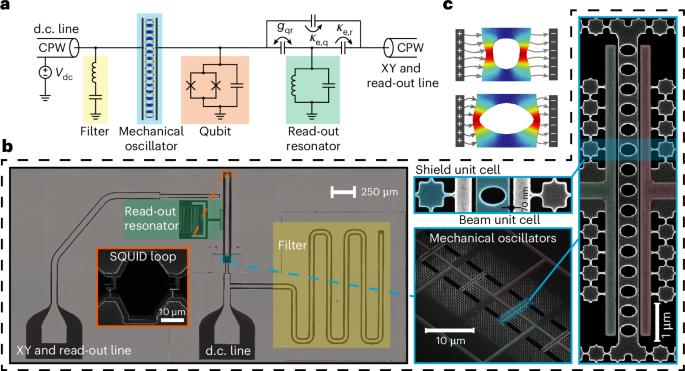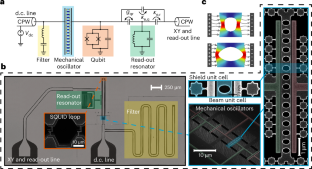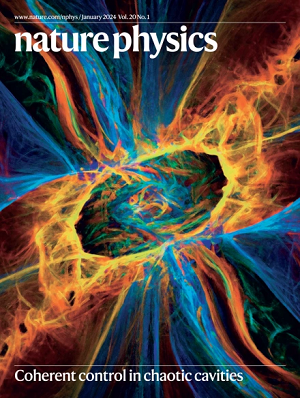A mechanical quantum memory for microwave photons
IF 18.4
1区 物理与天体物理
Q1 PHYSICS, MULTIDISCIPLINARY
引用次数: 0
Abstract
Superconducting qubits possess outstanding capabilities for processing quantum information in the microwave domain; however they have limited coherence times. An interface between photons and phonons could allow quantum information to be stored in long-lived mechanical oscillators. Here, we introduce a platform that relies on electrostatic forces in nanoscale structures to achieve strong coupling between a superconducting qubit and a nanomechanical oscillator with an energy decay time (T1) of approximately 25 ms, well beyond those achieved in integrated superconducting circuits. We use quantum operations in this system to investigate the microscopic origins of mechanical decoherence and mitigate its impact. By using two-pulse dynamical decoupling sequences, we can extend the coherence time (T2) from 64 μs to 1 ms. These findings establish that mechanical oscillators can act as quantum memories for superconducting devices, with potential future applications in quantum computing, sensing and transduction. Superconducting qubits, a leading platform for quantum information processing, suffer from decoherence. Interfacing them with nanomechanical oscillators allows quantum information to be stored in motional states with longer lifetimes.


微波光子的机械量子存储器
超导量子比特在微波域处理量子信息方面具有突出的能力;然而,它们的相干时间有限。光子和声子之间的界面可以使量子信息存储在长寿命的机械振荡器中。在这里,我们介绍了一个平台,该平台依赖于纳米级结构中的静电力来实现超导量子比特和纳米机械振荡器之间的强耦合,其能量衰减时间(T1)约为25 ms,远远超过了集成超导电路中所实现的。我们在该系统中使用量子运算来研究机械退相干的微观起源并减轻其影响。采用双脉冲动态解耦序列,可以将相干时间(T2)从64 μs延长到1 ms。这些发现表明,机械振荡器可以作为超导器件的量子存储器,在量子计算、传感和转导方面具有潜在的未来应用。
本文章由计算机程序翻译,如有差异,请以英文原文为准。
求助全文
约1分钟内获得全文
求助全文
来源期刊

Nature Physics
物理-物理:综合
CiteScore
30.40
自引率
2.00%
发文量
349
审稿时长
4-8 weeks
期刊介绍:
Nature Physics is dedicated to publishing top-tier original research in physics with a fair and rigorous review process. It provides high visibility and access to a broad readership, maintaining high standards in copy editing and production, ensuring rapid publication, and maintaining independence from academic societies and other vested interests.
The journal presents two main research paper formats: Letters and Articles. Alongside primary research, Nature Physics serves as a central source for valuable information within the physics community through Review Articles, News & Views, Research Highlights covering crucial developments across the physics literature, Commentaries, Book Reviews, and Correspondence.
 求助内容:
求助内容: 应助结果提醒方式:
应助结果提醒方式:


